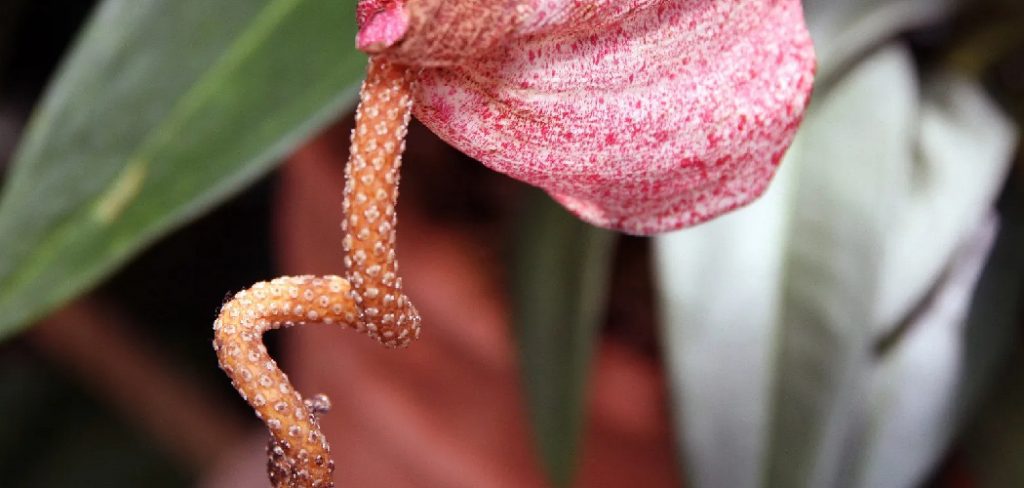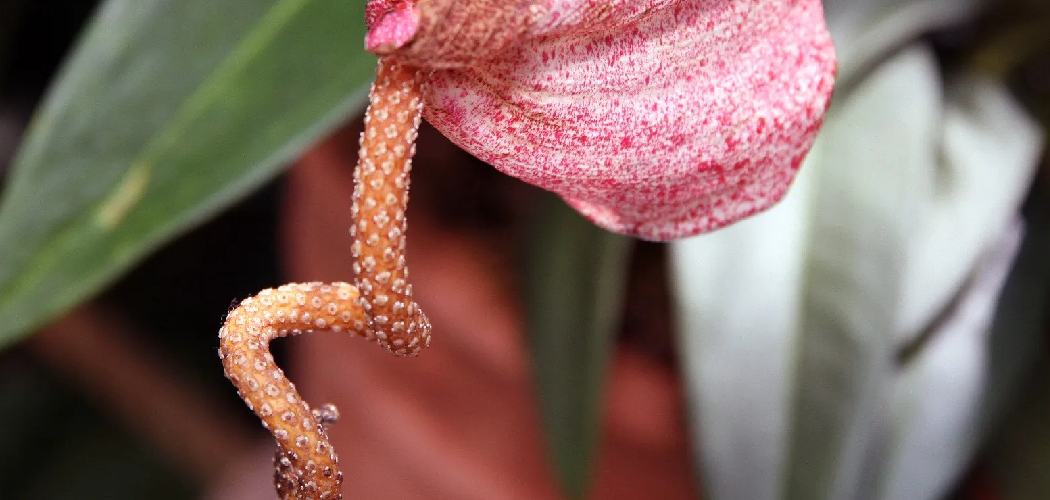To make an Anthurium bloom, provide it with indirect sunlight and water it regularly, ensuring the soil remains moist but not soggy. Welcome to our guide on how to make Anthurium plants bloom.

Anthuriums are known for their attractive, vibrant flowers, and with the right care, you can encourage these plants to bloom and thrive. This article will provide you with all the essential tips and techniques to make your Anthurium bloom. Whether you’re a seasoned gardener or a beginner, these guidelines will help you successfully cultivate beautiful Anthurium flowers.
So, let’s get started and unlock the secrets to a stunning Anthurium bloom.
Understanding The Anthurium Plant
Anthruim plants are known for their vibrant and long-lasting blooms, making them a popular choice among plant enthusiasts. There are several types of Anthurium plants available, each with its distinct characteristics. The Flamingo Flower variety, for example, features heart-shaped leaves and glossy, red blooms. On the other hand, the Crystal Anthurium boasts clear, translucent flowers.
The anatomy of an Anthurium plant consists of three main parts: the roots, the leaves, and the blooms. The roots provide support and absorb nutrients from the soil. The leaves come in various shapes and sizes, but they are typically glossy and waxy. The blooms, which are the main attraction of the plant, can be red, pink, white, or even green.
Important Factors For Anthurium Growth
- Light: Anthurium plants require bright, indirect light to thrive. Avoid exposing them to direct sunlight as it can scorch their leaves.
- Temperature and Humidity: These plants prefer warm temperatures ranging from 65-85°F and high humidity levels.
- Watering: Anthuriums should be watered thoroughly but allow the top inch of soil to dry out before watering again.
- Soil and Fertilizer: Well-draining soil enriched with organic matter is ideal for Anthuriums. Feed them with a balanced liquid fertilizer every two to four weeks during the growing season.
- Pruning and Propagation: Regular pruning helps promote new growth and maintain the shape of the plant. Anthuriums can be propagated through division or stem cuttings.
By understanding the different types of Anthurium plants and providing them with the right conditions, you can encourage blooming and enjoy their stunning flowers for years to come.
How to Make Anthurium to Bloom : Step by Step Guide
Creating The Ideal Environment For Blooming
Anthuriums require a warm and well-lit environment to bloom. They thrive in temperatures ranging from 70 to 90 degrees Fahrenheit. It is essential to place them in a well-lit spot, but avoiding direct sunlight can prevent leaf burn. A brightly lit room with filtered light is the best choice.
The soil plays a vital role in blooming Anthuriums. To promote optimal growth and blooming, use a well-draining potting mix with a pH level between 5.5 and 6.5. Adding organic matter such as shredded bark or coconut coir helps in retaining moisture without waterlogging the roots, promoting healthy flowering.
Anthruims prefer a higher level of humidity, around 60-70%. If the humidity in your environment is naturally low, using a humidifier or placing the plants on a tray filled with water and pebbles can help create the desired humidity level and ensure proper blooming. Additionally, providing adequate air circulation by placing the plant in a well-ventilated area prevents the risk of diseases and promotes flower production.
Providing Adequate Care
The key to making anthuriums bloom is to provide adequate care. This includes proper watering and drainage techniques. Anthuriums need to be watered regularly, but it is important to avoid overwatering as this can lead to root rot. Ensure that the plant is in a well-draining pot and that excess water can freely flow out.
In terms of fertilizer application, use a well-balanced fertilizer and follow the instructions on the packaging for the correct dilution and frequency. It is generally recommended to fertilize anthuriums every 2-4 weeks during the growing season.
Pruning and maintenance are also important for encouraging blooms. Regularly remove any dead or damaged leaves to promote healthy growth. Additionally, cutting back long stems can help stimulate new growth and increase the chances of blooming.
Providing proper care through adequate watering and drainage techniques, the right fertilizer application, and regular pruning and maintenance will help your anthuriums thrive and ultimately result in beautiful blooms.
Promoting Healthy Growth With Propagation Techniques
When it comes to promoting healthy growth and encouraging Anthurium plants to bloom, successful propagation techniques are key. Propagation methods for Anthurium include division, stem cuttings, and seed propagation.
When dividing an Anthurium plant, carefully separate the root system into smaller sections, ensuring each division has a healthy root system and a few leaves. Stem cuttings can be taken from a mature Anthurium plant, ensuring the cutting has at least two leaves and a small portion of the stem. Dip the cut end in rooting hormone before planting it in a well-draining potting mix.
Seeds can also be used to propagate Anthurium, although this method requires more time and patience. Collect mature seeds and plant them in a seedling tray filled with a well-draining growing medium. Keep the tray in a warm and humid environment and provide regular moisture.
Once you have successfully propagated your Anthurium plant, caring for the newly propagated plants is crucial. Ensure they are placed in a well-lit area, but away from direct sunlight. Maintain a consistent watering schedule, allowing the top inch of the soil to dry out before watering again.
Troubleshooting And Common Issues
Flowering plants like Anthurium can sometimes face issues when it comes to blooming. Troubleshooting and common issues play a crucial role in establishing a healthy blooming cycle. One such issue is the presence of pests and diseases. Identifying and treating these can ensure that the Anthurium flourishes.
Pests and diseases can hinder the blooming process of Anthurium. By recognizing environmental stress factors, such as excessive sunlight or inadequate humidity, one can address and alleviate these issues. Additionally, nutritional deficiencies can also impact flowering. Ensuring that the plant receives the correct balance of nutrients can greatly benefit its blooming potential.
By taking proactive measures against pests, diseases, environmental stress factors, and nutritional deficiencies, Anthurium can be encouraged to bloom vibrantly. A well-maintained and healthy Anthurium plant can bring joy and beauty to any space.
Enhancing Blooming With Extra Care
To ensure your Anthurium plant blooms beautifully, it requires extra care. Consider using growth stimulants and enhancers to boost the blooming process. These products can help in providing the necessary nutrients and support for healthy flower development.
Additionally, extra care tips can aid in promoting abundant and vibrant blooms. Provide your Anthurium plant with the right amount of sunlight as it plays a vital role in flower production. Adequate watering is also crucial; make sure the soil is moist, but not waterlogged.
Preventing and managing blooming challenges is equally important. Watch out for common issues such as pest infestations and diseases. Regularly inspect your plant for any signs of trouble and take appropriate action to combat these threats. Furthermore, proper pruning and fertilization techniques can contribute to healthier blooms.
Showcasing Your Blooming Anthurium
To make your Anthurium bloom, provide adequate sunlight, water, and fertilization. Ensure it is placed in a bright, indirect light environment and maintain consistently moist soil. Regularly feed it with a balanced fertilizer to encourage vibrant blooms.
Styling Tips For Displaying Anthurium Blooms
To give your Anthurium blooms the attention they deserve, style them strategically. Place a single bold Anthurium blossom in a unique and decorative vase to make a statement. Alternatively, create an eye-catching display by arranging a cluster of blooms in various sizes and colors. Experiment with contrasting foliage, such as broad-leaf plants or delicate ferns, to bring out the vividness of the Anthurium flowers. For a chic touch, consider showcasing your Anthuriums alongside other flowers in a mixed bouquet, creating a striking visual contrast. Remember to change the water regularly and trim the stems every few days to ensure longevity.
Creative Ideas For Arrangements And Bouquets
Anthirium blooms provide endless opportunities for creative floral arrangements. Combine Anthurium flowers with tropical foliage, such as palm leaves or bird of paradise flowers, to create an exotic arrangement. For a contemporary look, arrange Anthuriums in a clear glass vase with modern elements like branches or succulents. Consider incorporating Anthuriums into unique floral sculptures or terrariums, allowing their vibrant colors to shine. Amp up the visual impact by experimenting with different shapes, textures, and heights in your arrangements. Don’t shy away from thinking outside the box to create stunning floral masterpieces!
Longevity Tips For Prolonged Blooming
To extend the blooming period of your Anthuriums, follow these tips. Place your Anthurium plant in a bright but indirect light to avoid scorching the leaves and flowers. Maintain a consistent temperature between 70-90°F (21-32°C) to optimize growth and blooming. Ensure proper watering by allowing the top inch of soil to dry out between watering sessions. Avoid overwatering, which can cause root rot. Fertilize your Anthurium every two to four months using a balanced liquid fertilizer to provide essential nutrients. Finally, keep an eye out for any signs of pests or diseases and take appropriate measures to protect your Anthuriums.
Frequently Asked Questions For How To Make Anthurium To Bloom
Why Is My Anthurium Not Flowering?
Anthurium may not flower due to insufficient light, incorrect watering, low humidity, or nutrient deficiencies. Provide bright indirect light, water when the top inch of soil is dry, increase humidity, and use a balanced fertilizer every month to encourage flowering.
What Time Of Year Do Anthurium Bloom?
Anthuriums typically bloom year-round, but they tend to produce more flowers during the warmer months.
How Long Does Anthurium Take To Flower?
Anthurium usually takes about six to eight weeks to flower, provided it receives proper care and favorable growing conditions.
Is Epsom Salt Good For Anthurium Plants?
Yes, Epsom salt is good for anthurium plants. It provides magnesium, which helps in chlorophyll production and overall plant growth. Dissolve 1 tablespoon of Epsom salt in a gallon of water and apply it to the plant once a month for best results.
Conclusion
To ensure you have beautiful blooming anthuriums, follow these simple but effective tips. Proper lighting and temperature, regular watering, and providing the right nutrients are essential factors. Additionally, maintaining good air circulation and repotting when necessary can further improve blooming outcomes.
Remember, patience is key when it comes to anthuriums. By following these guidelines, you’ll be rewarded with stunning, vibrant blooms that will light up your space. Happy gardening!

